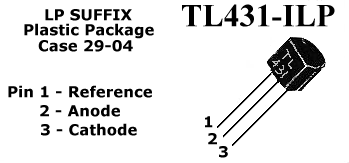![[Cycler for 4.8 Volt Receiver]](cycler1.gif)
![[Cycler for 9 Volt Transmitter]](cycler2.gif)
![[Cycler for 4.8 Volt Receiver]](cycler1.gif)
![[Cycler for 9 Volt Transmitter]](cycler2.gif)
| Part | Description | Radio Shack | Digikey | Notes |
|---|---|---|---|---|
| IC1 | TL431ILP, Motorola LM431 NTE999 |
n/a | 296-1292-ND | Prec. Voltage Ref. |
| D1, LED | Light Emitting diode | P374-ND | 5mm, red | |
| D2 | 1N4001, diode | 1N4001DICT-ND | Gen. Purp. Rec. | |
| R1 | 470 ohm, resistor | 271-1317 | 5%, 1/4W, carbon | |
| R2/R3 | 10 ohm, resistor | 271-132 | 5%, 25W, WW | |
| R4 | 1.5K, resistor | 5%, 1/4W, carbon | ||
| P1 | 10K, trimmer-pot | 10-turn, Bourns | ||
| K1 | 5V-1A, relay | 275-240 (5V) | 3V type is best | |
| S1 | SPST, switch | 275-8077 | momentary 'on' |
| Part | Description | Radio Shack | DigiKey | Notes |
|---|---|---|---|---|
| IC1 | TL431ILP, Motorola | n/a | 296-1292-ND | Prec. Voltage Ref. |
| D1, LED | Light Emitting diode | P374-ND | 5mm, red | |
| D2 | 1N4001, diode | 1N4001DICT-ND | Gen. Purp. Rec. | |
| R1 | 1K, resistor | 271-1321 | 5%, 1/4W, carbon | |
| R2/R3 | 10 ohm, resistor | 271-132 | 5%, 5W, WW | |
| R4/R5 | 10 ohm, resistor | 271-132 | 5%, 5W, WW | |
| R6 | 10K, resistor | 271-1335 | 5%, 1/4W, carbon | |
| P1 | 10K, trimmer-pot | 10-turn, Bourns | ||
| K1 | 7V-2A, relay | 275-005 (7V) | 6V preferred | |
| S1 | SPST, switch | 275-8077 | momentary 'on' |
 TL431ILP senses the preset
voltage reference and trips the relay when that control voltage point is reached, adjusted with the 10-turn trimmer
pots, which in turn activates the charger. The resistors used in this circuit provide an approximate discharge
rate of 250mA. Since the remainder of the circuits power is also provided by the battery being discharged, an
additional 50mA or so is discharged from the NiCad battery packs. The relay is configured as latch so that once the
unit trips from discharge to charge, the unit cannot be recycled until the start switch is pressed. The component
values, setting up the discharge values and trip points can be adjusted to handle any size or battery voltage up to
the 30 volt maximum rating of the TL431. Remember, the relay coil voltage must also be taken into consideration when
changing the operating voltage of the circuit. All components listed in the circuit can be easily obtained from your
local electronics store or Tandy/Radio Shack, although the TL431 may have to be ordered in. If you find a significant
drop in discharge time you have a clue that something is going bad with your pack and close examination or a new
purchase may be needed.
TL431ILP senses the preset
voltage reference and trips the relay when that control voltage point is reached, adjusted with the 10-turn trimmer
pots, which in turn activates the charger. The resistors used in this circuit provide an approximate discharge
rate of 250mA. Since the remainder of the circuits power is also provided by the battery being discharged, an
additional 50mA or so is discharged from the NiCad battery packs. The relay is configured as latch so that once the
unit trips from discharge to charge, the unit cannot be recycled until the start switch is pressed. The component
values, setting up the discharge values and trip points can be adjusted to handle any size or battery voltage up to
the 30 volt maximum rating of the TL431. Remember, the relay coil voltage must also be taken into consideration when
changing the operating voltage of the circuit. All components listed in the circuit can be easily obtained from your
local electronics store or Tandy/Radio Shack, although the TL431 may have to be ordered in. If you find a significant
drop in discharge time you have a clue that something is going bad with your pack and close examination or a new
purchase may be needed.